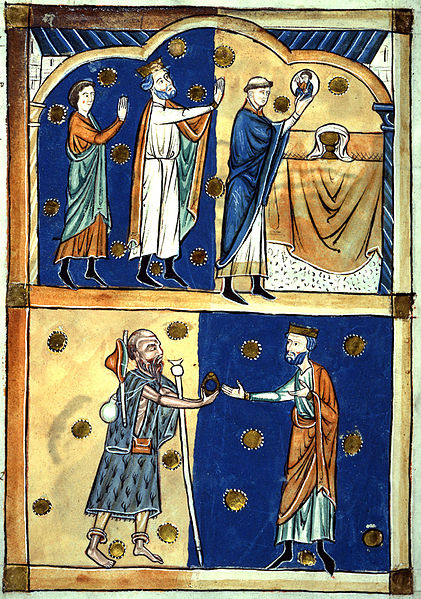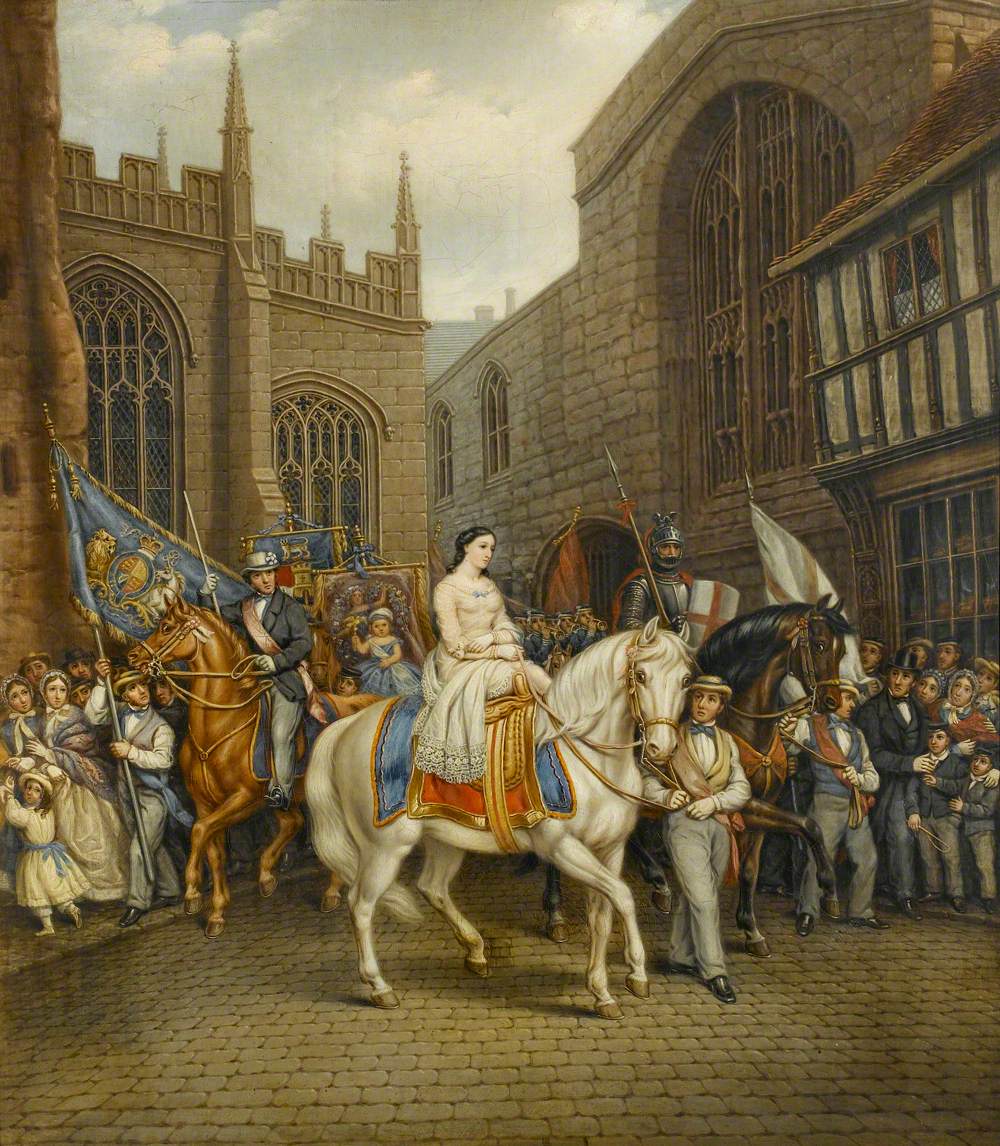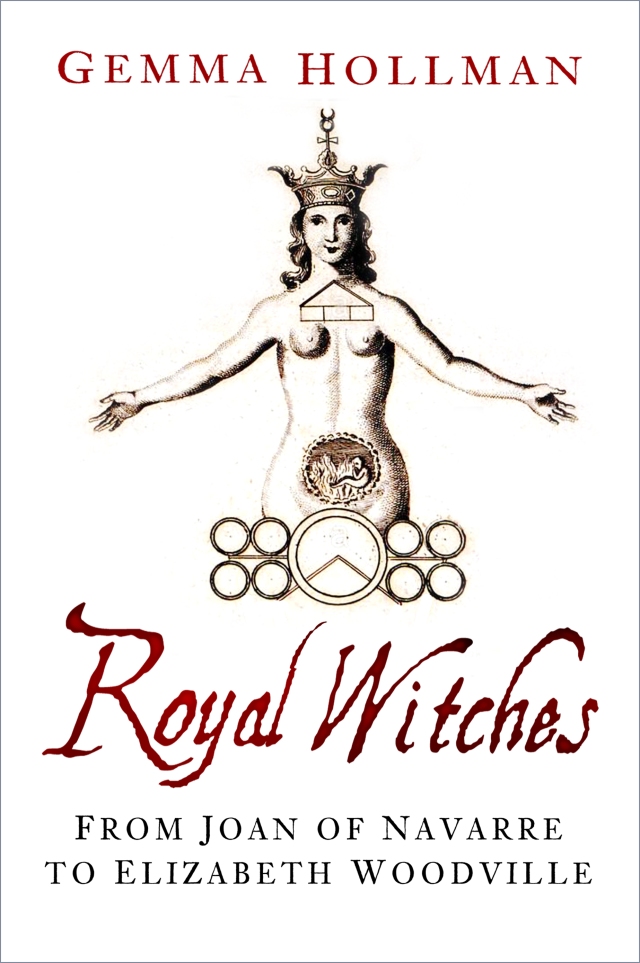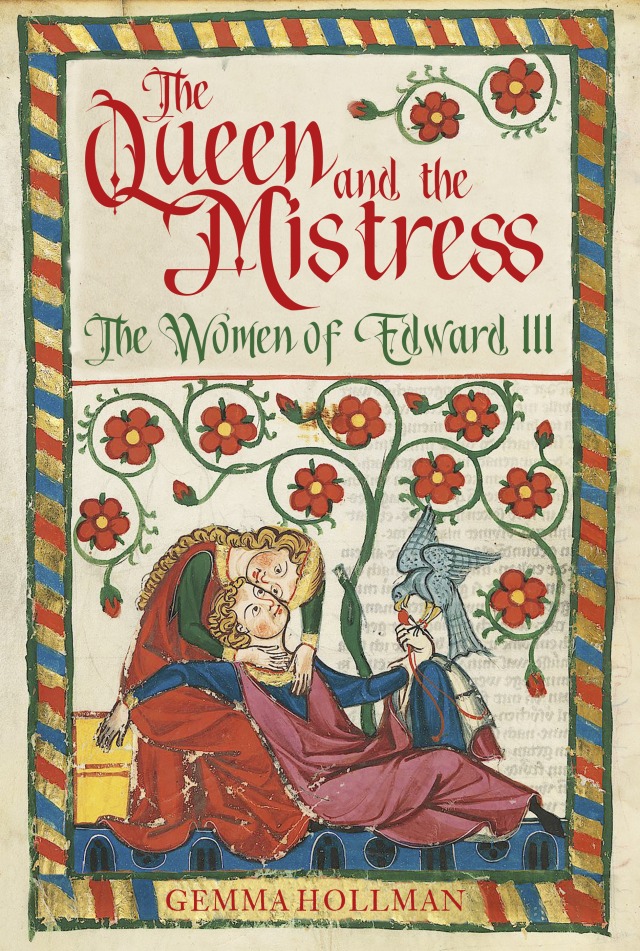This is the first post in a new series I’ve been wanting to start for a while now. With medieval history in particular, there are lots of figures who have taken on legendary status. Some of these may have had real, historic roots, whilst others were purely fictional, but in the centuries since people have tried to find historic basis in them. So, I’d like to explore some of these people and see what real history may lie behind them. First up, I’ve gone for Lady Godiva.
The story of Lady Godiva first appears in written form in Roger of Wendover’s Flores Historiarum [Flowers of History] compiled between 1188 – 1235. Roger was a monk at St Albans Abbey, and used material previously existing at the Abbey which was supposedly begun by another monk, John de Cella. Roger recounts the story of Lady Godiva thusly:
“[A.D. 1057] On the thirty-first of August in the same year died Leofric earl of Chester, a man of praise-worthy life ; he was buried in the monastery which he had founded at Coventry. Having founded this monastery by the advice of his wife the noble countess Godiva, he, at the prayer of a religious woman, placed monks therein, and so enriched them with lands, woods, and ornaments, that there was not found in all England a monastery with such an abundance of gold and silver, gems and costly garments. The countess Godiva, who was a great lover of God’s mother, longing to free the town of Coventry from the oppression of a heavy toll, often with urgent prayers besought her husband, that from regard to Jesus Christ and his mother, he would free the town from that service, and from all other heavy burdens ; and when the earl sharply rebuked her for foolishly asking what was so much to his damage, and always forbade her ever more to speak to him on the subject ; and while she, on the other hand, with a woman’s pertinacity, never ceased to exasperate her husband on that matter, he at last made her this answer, “Mount your horse, and ride naked, before all the people, through the market of the town, from one end to the other, and on your return you shall have your request.”
On which Godiva replied, “But will you give me permission, if I am willing to do it?” “I will,” said he. Whereupon the countess, beloved of God, loosed her hair and let down her tresses, which covered the whole of her body like a veil, and then mounting her horse and attended by two knights, she rode through the market-place, without being seen, except her fair legs ; and having completed the journey, she returned with gladness to her astonished husband, and obtained of him what she had asked ; for earl Leofric freed the town of Coventry and its inhabitants from the aforesaid service, and confirmed what he had done by a charter. The said earl also, at the instigation of his countess, munificently enriched with lands, buildings, and various ornaments the churches of Worcester, St. Mary of Stone, and St. Wareburg, with the monasteries of Evesham, Wenloc, and Lenton.”

Lady Godiva after Leofric gave her his conditions, a painting by Edmund Blair Leighton, 1892.
Over the centuries, the story was expanded, but the core stayed the same. At some time during the 17th or 18th century, Lady Godiva’s ride had taken on a new character in the form of “Peeping Tom”. In the later version of the story, rather than parade through a crowded street, Lady Godiva asked the townspeople to stay inside and away from their windows during the ride, so that she was not at risk of being seen. The townspeople, being respectful of Godiva for what she was doing for them, agreed – but one man, a tailor, could not resist looking at her as she rode by. What happens next varies from version to version, but the man was either struck blind by God as punishment, or the townspeople were so angry at him for his betrayal that they blinded him themselves.
After how I began this article, it probably is needless to say that sadly this story has very little historical basis – but, unlike other legendary figures, we know for certain that Godiva was a real person. Godiva and her husband Leofric are mentioned plenty in contemporary sources, because they were some of the most powerful people in the country. Leofric was Earl of Mercia, and below the king he was only second in power to Earl Godwin of Wessex. Countess Godiva, or ‘Godgifu’, was by connection also one of the most powerful people in the land, although she held much of this power herself; she held many lands in her own right (as Anglo-Saxon women were allowed to do so). In fact, the Domesday Book records Godiva as one of the few Anglo-Saxons, and the only woman, to remain a major landholder shortly after the 1066 Norman Conquest. Godiva had died some time between 1066 and the survey in 1086, but the lands she had formerly owned were still listed. There were still some of her lands in Leicestershire, Nottinghamshire, and Warwickshire to be re-granted, which gives some idea of the places she held influence in.

A drawing of the statue of Peeping Tom used in the Coventry parade, drawn by W. Reader, 1826.
Godiva and Leofric were very generous to the church in their wealth. Their names crop up time and again giving donations of land or objects to various religious institutions. For example, in 1043 Leofric founded and endowed a Benedictine monastery at Coventry on the site of a nunnery destroyed by the Danes in 1016, and in the 1050s the couple granted land to the monastery of St. Mary, Worcester and endowed the minster at Stow St Mary, Lincolnshire. They also were benefactors of monasteries at Leominster, Chester, Much Wenlock, and Evesham. Godiva herself was individually generous to the church, bequeathing numerous gifts of precious metals to Coventry itself, as well as a necklace valued at 100 marks of silver – a significant amount in this period. She gave another necklace to Evesham, to be hung around the figure of the Virgin accompanying the life-size gold and silver rood she and her husband had given, whilst St Paul’s Cathedral in the City of London received a gold-fringed chasuble [liturgical vestment]. Many of these gifts and donations are mentioned in Roger’s first story of Godiva, and so tales of their generosity were clearly still to be found two centuries after their deaths.
However, the retelling of their religious generosity is the closest to the truth we get in Roger’s story. Leofric was clearly a generous man, his gifts going beyond the usual level for most nobles at the time, thus suggesting real generosity rather than manufactured or mandatory. There are no contemporary accounts that suggest he was cruel, and in fact he seems to have quite good political judgement. This seems to be at odds with the idea of a cruel overlord who would humiliate his wife in such a way – particularly as to demean his wife by riding naked through the streets in front of her subjects would undermine his own reputation and authority.

A depiction of Leofric (top left) with King Edward the Confessor, from an abridgement of the Domesday Book, c. 1240.
Moreover, it appears that Godiva was actually overlord of Coventry in her own right, as part of her independent lands – this would mean that it was Godiva herself who would have been responsible for taxation in Coventry, and not her husband at all. Therefore, if she wished to have their taxes reduced, she could do so herself. Looking at the location of Coventry as the setting, further questions are raised. At the time of Godiva’s supposed ride, Coventry wasn’t even a significant town – there were only 69 families and the monastery recorded in the Domesday Book, and it seems likely there were probably only around 300 people. It may not even have had a marketplace for Godiva to ride through, and would she really risk so much to relieve the tax of a few hundred people? The final nail in the coffin seems to be that the only recorded tax for the people of Coventry at that time were tolls on horses – hardly unreasonable, and again, would it be worth risking so much to abolish the one and only tax?
However, some people have still used this as evidence of the story’s truth. Ranulf Higden, a monk writing in the early 14th century, tells the story in his chronicle, the Polychronicon, and he says that after Godiva’s ride, Leofric freed the town from all of their taxes apart from the one on horses. Thus, seeing that indeed the people of Coventry were only paying taxes on their horses seems to confirm this story. Another argument of defence comes from Roger’s original story. Although written 200 years after the supposed event, for medieval chronicles that isn’t necessarily too far away from the events to be discounted completely. Many argue that although the story wasn’t recorded by her immediate contemporaries, the story carried on in oral tradition until Roger finally wrote it down. They point to the fact that although the other editor of Roger’s chronicle, Matthew Paris (another monk at St Albans at the same time as Roger), was known to embellish his accounts to add more interest, that is quite a significant story with particular detail to spring out of Matthew’s imagination. Some argue that therefore, Roger and Matthew must have heard the story from elsewhere – perhaps from the aforementioned oral tradition.

A statue of Lady Godiva by P Pargetter, 1867.
This seems to be confirmed by a chronicler from the 1560s, Richard Grafton, who references a lost chronicle written by the prior of the monastery of Coventry between 1216 and 1235 that Grafton claims was the first source that mentions the story of Godiva. To come from the original monastery, many believe this lends extra credence to the legend.

Enjoying this blog post? Buy me a hot chocolate!
Consider donating the cost of a hot chocolate to me, so I can continue to write and run Just History Posts.
£3.50
In reality, no one knows where the legend of Godiva first came from. Some claim that Roger and Matthew were influenced by Celtic and Nordic mythology, where stories of wealthy and beautiful women who are linked to horses abound (such as the Celtic goddess Epona, or the Welsh goddess Rhiannon). There are also apparently ceremonies in fertility cults where a woman would ride naked on a horse to benefit her community. Perhaps the two monks had heard such stories, and when they came across a powerful, rich woman who was very generous to her subjects, they decided she fitted the character that could be used to tell one such story.

A painting of a Godiva procession in Coventry, 1829, where the lady wore a skin-coloured dress to (modestly) recreate the scenes. Painted by David Gee.
Historians are in general agreement that the story of Lady Godiva riding naked through the streets of Coventry is entirely fictional. There are no contemporary accounts of the ride – which, if one of the most powerful ladies in the land rode naked through the streets, the gossiping chroniclers certainly would have recorded it – and the story doesn’t seem to fit the character of her husband, Leofric. Godiva herself administrated Coventry, so would have had no need for the ride in any case. This does not mean Godiva is not an interesting person. She was one of the most powerful women of her time, and one who remained powerful against the odds after the Norman invasion. She was incredibly generous, and she was even the grandmother of a queen; her and Leofric’s son, Ælfgar, had a daughter, Edith (or Ealdgyth) who married firstly Gruffudd ap Llywelyn, King of Wales, and secondly Harold Godwinson, making her the last queen of Anglo-Saxon England. Nonetheless, the legend of Lady Godiva remains overwhelmingly popular today.
Previous Blog Post: The Spanish Armada of 1588
You may like: Stand and Deliver, Your Money or Your Life: Female Highwaymen of the Seventeenth Century
List of Blog Posts: here Blog Homepage: here
Buy my books via the pictures below! Or why not check out our shop?

Follow us:
You can read more here:
http://www.bbc.co.uk/history/ancient/anglo_saxons/godiva_01.shtml
http://www.history.com/news/ask-history/who-was-lady-godiva
https://archive.org/stream/rogerofwendovers01rogemiss#page/314/mode/2up






The more I think and learn about this story, the stranger I find it. Something must have happened. The story is shocking in so many ways. We tend to think that her modesty was preserved because her hair covered her, but it would have been almost as shocking for her to be seen with her hair uncovered as it would have been for her to be seen naked.
LikeLike
Yes it certainly is a very peculiar story that you certainly wonder where the idea originated from because it is so odd and shocking! And yes that is a very good point about her hair – one of those things that frustratingly we will never know what really happened!
LikeLiked by 1 person
This is awesome! I didn’t know any of this stuff, outside of the legend. Thanks for doing the research and putting this together 🙂
LikeLike
Thank you! I’m glad you enjoyed it. I always think its fun to get to the root of the legends!
LikeLike
Reblogged this on Lenora's Culture Center and Foray into History.
LikeLike